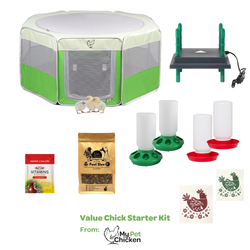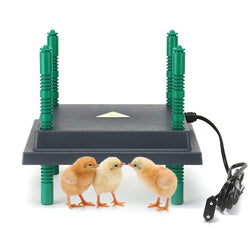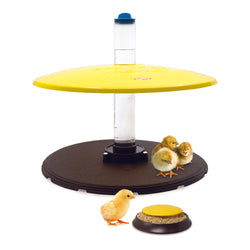Polish Chicken Breed: The Complete Guide
Back to blog
In the realm of poultry, few breeds capture the imagination quite like the Polish chicken. With its regal crest of feathers and its aura of distinction, the Polish chicken stands as a true living work of art.
In this blog, we invite you to embark on a journey through the captivating universe of the Polish chicken. From its history origins to its unique personality and care requirements, we will explore every facet of this remarkable breed.

History of the Polish Chicken
The Polish chicken breed, also known as the Poland, Tophat, or Padua breed, is a unique and distinctive poultry breed known for its ornamental and striking appearance. The Polish chicken breed's history is fascinating and dates back several centuries.
The exact origins of the Polish chicken breed are unclear, but it is believed to have originated in Eastern Europe, possibly in Poland or the Netherlands. The breed was initially developed for ornamental purposes due to its distinct appearance and unique crest of feathers on top of its head. It's important to note that the Polish chicken was primarily bred for its ornamental qualities rather than its egg or meat production
Personality
Polish chickens are known for their distinctive appearance and often quirky personalities. While individual personalities can vary, here are some general traits and characteristics commonly associated with Polish chickens:
- Gentle and Docile: Polish chickens are generally gentle and docile birds. They are often quite tame and can be friendly with their keepers. This makes them suitable for families or backyard enthusiasts who want a visually striking bird with a friendly disposition.
- Curious and Active: These chickens tend to be curious and active, often exploring their surroundings with interest. They enjoy foraging and scratching around the yard. Their active behavior can make them fun to watch and interact with.
- Skittish: Due to their limited vision caused by their crest of feathers covering their eyes, Polish chickens can sometimes be skittish and easily startled. Sudden movements or loud noises might cause them to panic. Therefore, they might need a more secure and protected environment compared to other chicken breeds.
- Social: Polish chickens are usually social birds and usually get along well with other chickens and even other types of poultry. They often prefer to be part of a flock and might feel stressed or lonely if kept alone.
- Non-Aggressive: Polish chickens are generally not aggressive towards humans or other chickens. They don't usually exhibit aggressive behaviors like pecking or bullying, making them suitable for mixed flocks with different breeds.
- Vulnerable: Polish chickens can be more vulnerable to predators because of their limited vision due to their crest. They might not see predators approaching as easily as other chickens, so providing a safe and secure coop and run is essential for their well-being.
- High-Maintenance: Polish chickens might require extra care due to their crest. Their crest can get dirty easily, leading to eye infections or other health issues if not managed properly. Regularly cleaning their feathers and keeping the crest area free from debris is important.

The Appearance of Polish Chickens
Polish chickens are known for their striking and unique appearance, which sets them apart from many other poultry breeds. Their most notable feature is the crest of feathers on top of their heads. However, the appearance of them can vary based on the specific variety or color pattern. Here are some key characteristics of their appearance:
- Crest of Feathers: The most distinctive feature of this chicken breed is their crest of feathers on top of their heads. This crest can vary in size and shape, and it often giving them a "pom-pom" or "top hat" appearance. The crest can partially or completely cover their eyes, leading to their distinctive look.
- Feather Colors: Polish chickens come in various feather colors, including white, black, buff-laced, silver-laced, golden-laced, blue, and more. Each color variation contributes to their overall visual appeal.
- Bearded and Non-Bearded Varieties: Some varieties have additional facial feathering, known as a beard. This is a fluffy collection of feathers under the beak area, which adds to their distinctive appearance.
- Upright Posture: Polish chickens typically have an upright and elegant posture, making them stand out in a flock.
- Small to Medium Size: They are relatively small to medium-sized birds, with hens weighing around 4-5 pounds and roosters weighing around 5-6 pounds.
- Clean Legs and Feet: Polish chickens have clean, feather-free legs and feet, which adds to their overall appearance and distinguishes them from feather-legged breeds.
Egg Color and Production
- Egg Color: The egg color of this breed varies based on the variety. Most Polish chickens lay white eggs, but some varieties might lay cream-colored or tinted eggs. The specific egg color will depend on the genetic makeup of the individual bird.
- Egg Production Rate: They are not typically known for high egg production rates compared to other chicken breeds specifically bred for prolific egg-laying. Their primary focus historically has been on their ornamental qualities rather than egg production. As a result, they tend to have a moderate to low egg production rate.
On average, you might expect a Polish hen to lay around 150 to 200 eggs per year, but this can vary widely based on factors such as genetics, diet, health, and environmental conditions. Some individual Polish hens might lay more eggs, while others might lay fewer.
It's important to note that if you're primarily interested in egg production, other chicken breeds that are more renowned for their high egg-laying capabilities. Polish chickens are often chosen for their unique appearance, personality, and ornamental value rather than their egg production.
Care and Health for Polish Chickens
Polish chickens have unique health and care needs due to their distinctive crest of feathers on their heads. This crest can sometimes make them more vulnerable to certain health issues. Here are some special considerations for their health and care:
- Eye and Crest Care: Because the crest of feathers can partially or completely cover their eyes, Polish chickens might be more prone to injuries. Regularly check their eyes for signs of redness, swelling, discharge, or any abnormalities. Keep the crest area clean and free from debris. Feathered crests can easily collect dirt, moisture, and parasites, leading to potential health problems. Trimming the feathers around their eyes can help prevent vision obstruction and reduce the risk of eye-related issues.
- Protection from Predators: Due to their limited vision caused by the crest, Polish chickens can be more vulnerable to predators. Provide them with a secure, predator-proof coop and run to ensure their safety.
Polish chickens are not particularly hardy in cold weather. Their ornamental crest of feathers and smaller body size can make them more susceptible to cold temperatures and winter weather challenges. The average life span of this chicken breed is 5-8 years.
My Pet Chicken offer Polish Chickens for sale:
- Buff Laced Polish
- Silver Laced Polish
- Golden Laced Polish
- White Crested Blue Polish
- White Crested Black Polish
- Bantam White Crested Black Polish
Do you have any Polish chickens in your flock? Share with us in the comments below.
Ready to grow your flock? Discover all our day-old baby chicks and choose your perfect match.




9 comments
Our bantam polish 2 weeks is already starting to seem like a boy! A little pink/red by the wattle and a little squared off at the comb/nose. He/she seems a bit alpha in terms of being a bit in charge and flies really well. If it turns out that Foxy is a he, will “his” cockiness/aggression be offset by the fact that he is a bantam? I have some old and kind-of vulnerable ladies
———
My Pet Chicken replied:
New young chicks can have very distinct personalities and don’t necessarily mean that you have a sexing error. With our sexing error guarantee, you can send in a photo of this chick between 14-22 weeks of age and we will evaluate the feathers to confirm sex. Each roo will have his own style and while some smaller birds will be gentle, others may not. We would be happy to discuss this with you in live chat!
We have 2 frizzle tolbunt polish chicks. One is 4 weeks old and the other is 3 weeks old. They are adorable and odd looking. But I love them so much! Names are Cotton and Fluffy.
———
My Pet Chicken:
Cotton and Fluffy sound absolutely adorable! Frizzle Tolbunt Polish chicks are such unique little characters. Enjoy their quirky looks and sweet personalities—they’re sure to bring you lots of joy! 😊
I’m the proud mama of 2 polish chickens in my small flock! Purchased them as chicks in March this year. An all white name Cyndi Lauper, A black with white crest head named Tina Turner. They are both active and laying good and get along well with the rest of my small flock! The entertainers of the Flock!!
———
My Pet Chicken replied:
The names you picked out for your polish are absolutely adorable! We are thrilled to hear how much you enjoy them!
I just got two 1-week old Polish chicks. They were peeping so loud all last evening, so I held them awhile to calm them down. I remembered the stuffed animal chicken I have for the grandkids and put it in with the chicks. They have been so content since with their new mama. So excited to have Polish birds…a breed I’ve wanted ever since I thought about having chickens. I have 3 Belgium Anvers, which are 10 weeks old. I’m hoping they all get along as the Anvers are smaller birds. Time will tell 😃
———
My Pet Chicken replied:
Congratulations on your new Polish chicks! I am sure they will be quite happy with your Anvers. Polish are a great breed with those beautiful crests and lively, curious personalities for sure!
fantastic